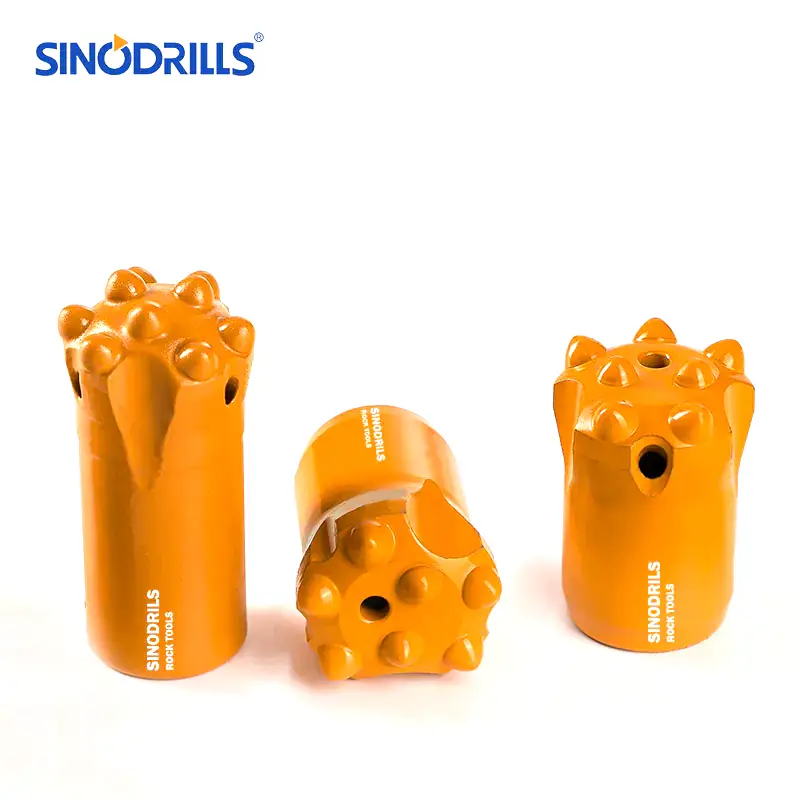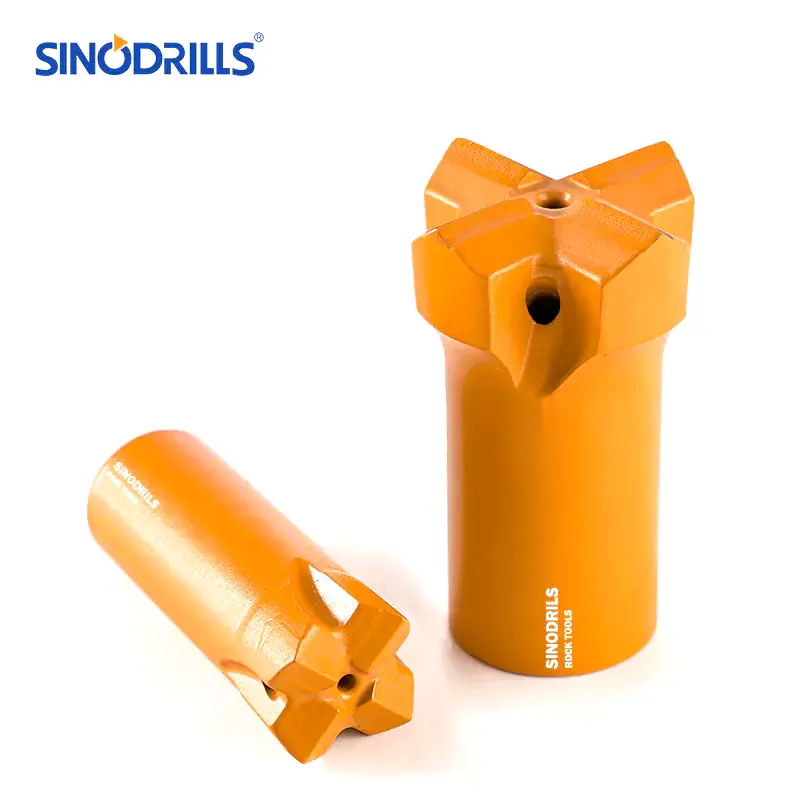Carbide button bits are essential tools in drilling, renowned for their durability and efficiency. The quality of these bits heavily relies on how their carbide buttons are inserted, a process critical for their performance and lifespan. Understanding the various insertion methods is key to appreciating the engineering behind these robust drilling components.
This blog post will delve into three primary methods of inserting carbide buttons into button bits: hot pressing, cold pressing, and brazing. Each technique offers distinct advantages and is chosen based on specific application requirements and material properties, influencing the bit’s overall effectiveness in different drilling conditions.
What are Inserting Carbide Buttons?
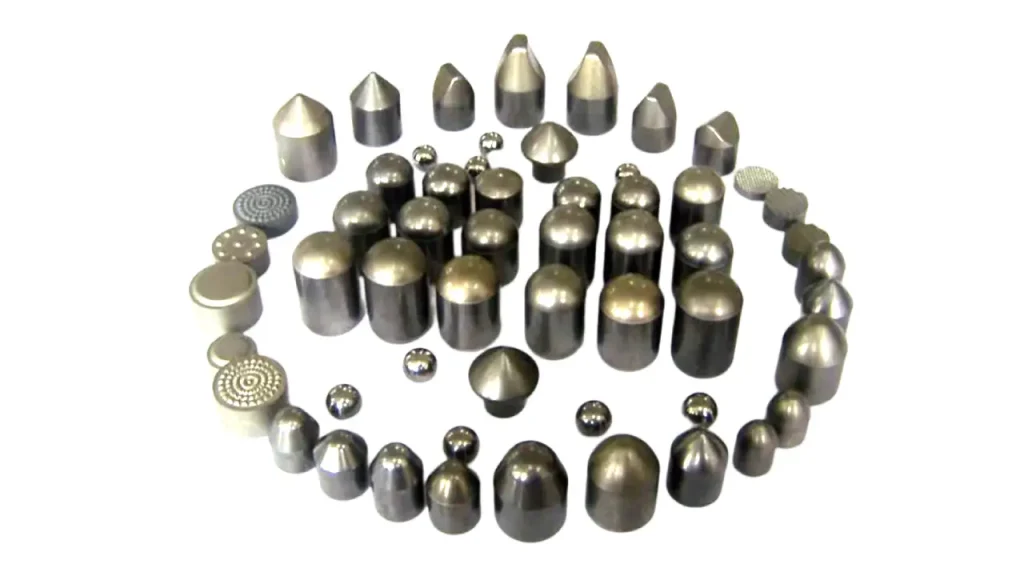
Inserting carbide buttons refers to the process of embedding small, highly durable inserts made from tungsten carbide into the steel body of drill bits or other cutting tools. These buttons, typically hemispherical, conical, or parabolic in shape, act as the primary cutting or crushing elements that engage with rock or other hard materials.
The purpose of inserting these extremely hard carbide components is to significantly enhance the drill bit’s wear resistance, cutting efficiency, and overall lifespan, allowing for more effective and economical drilling operations in demanding environments like mining, construction, and oil and gas exploration.
What are Drill Bit Inserts?
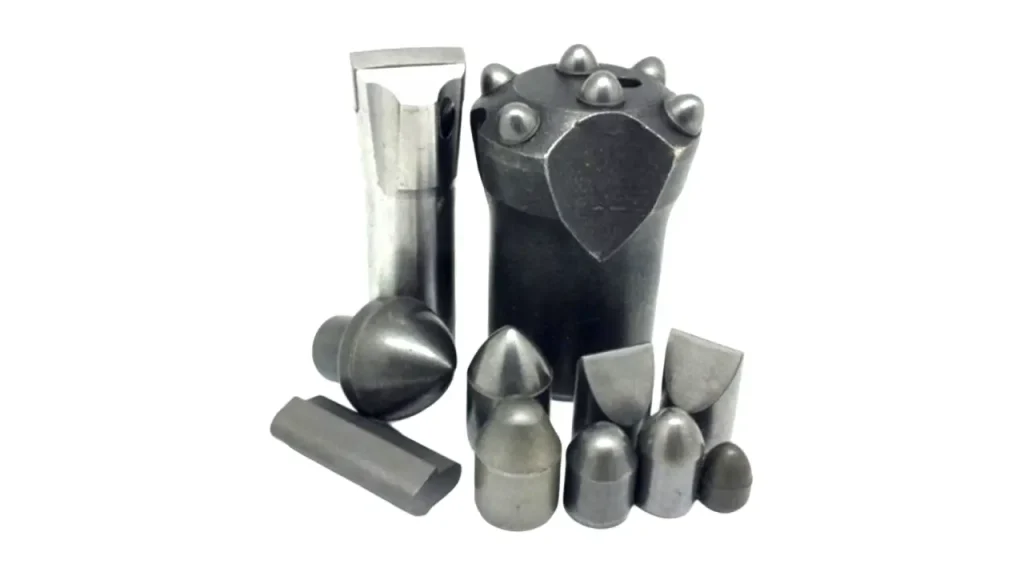
Drill bit inserts, often referred to as “buttons” or “carbide inserts,” are the primary cutting elements of many modern rock drill bits. They are typically made from extremely hard and wear-resistant materials, most commonly cemented tungsten carbide. These inserts are precision-engineered and pressed into the steel body of the drill bit, where they bear the brunt of the drilling forces. The design and placement of these inserts are crucial for optimizing a bit’s performance for specific rock types and drilling applications. Their primary functions include:
- Rock Fragmentation: The inserts crush, chip, or shear the rock, breaking it into smaller pieces to create a borehole.
- Wear Resistance: Being significantly harder than the steel bit body, the inserts protect the bit from abrasive wear, extending its lifespan.
- Drilling Efficiency: Different shapes and grades of carbide inserts are used to maximize penetration rate in varying rock formations, from soft and fractured ground to extremely hard and abrasive rock.
- Enhanced Durability: The inserts allow the bit to withstand the high-impact forces and high temperatures generated during rock drilling.
3 Methods of Inserting Carbide Buttons
The effective insertion of carbide buttons into drill bits is paramount for their performance and longevity. Different methods are employed to ensure a secure and durable bond between the hard carbide and the softer steel body of the drill bit.
Let’s explore three prominent techniques: copper brazing, cold pressing, and hot pressing. There are three methods for inserting carbide buttons: copper brazing, cold press, and hot press.
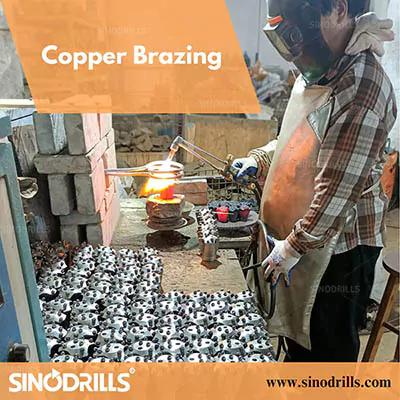
1. Copper Brazing:
Copper brazing is the earliest way of inserting carbide buttons, primarily determining the size of the hole and the carbide button based on the gap during brazing. According to the bit skirt structure, corresponding button holes are drilled into the bit skirt, and then the carbide buttons are welded into the bit skirt using copper or silver welding techniques.
This method does not require high precision for the drilling or button size. During brazing, the brazing material is placed at the bottom of the carbide button, with some flux sprinkled on the carbide button surface. The brazing material diffuses fully in an oxygen-free condition, forming a dense, uniform, and full weld. The hole only bears the radial and tangential stresses caused by the condensation shrinkage of the weld, with no axial tensile or compressive stress. Additionally, this layer of brazing material can delay the impact during rock drilling, thus avoiding the disadvantages of interference fit.
However, the high temperatures during welding impose thermal stresses, potentially causing defects and micro-crack propagation in the low cobalt alloy, as well as reduced hardness (by HRC 0.5-0.8 ) and bending strength (by 8%-20%) of the carbide. The formation of an oxide layer on the surface of the alloy button makes the carbide button prone to fracture.
Currently, this method is mainly used for single used button bits, such as blast furnace tapping bits and anchor bits.
During the copper brazing process, the brazing alloy is placed at the bottom of the carbide button, often with a flux. The assembly is then heated in an oxygen-free environment, allowing the brazing material to melt and flow, creating a strong, dense, and uniform bond. While this method offers good impact resistance by delaying shock, the high temperatures can induce thermal stresses and potentially reduce the hardness and bending strength of the carbide.
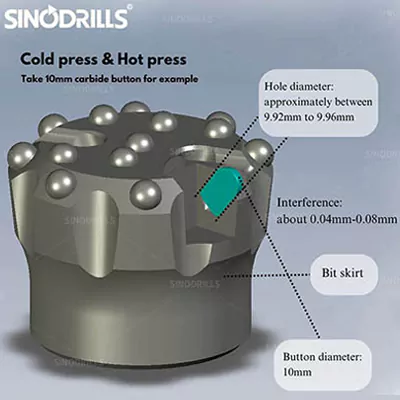
2. Cold Press
Cold press and hot press both utilize interference fit to fix the carbide buttons, and the interference is generally between 0.04mm and 0.08mm. Factors influencing the interference include, but are not limited to:
- 1. Drill bit skirt material;
- 2. Heat treatment process of the skirt;
- 3. Diameter of the carbide buttons;
- 4. The equipment for inserting carbide buttons into the bit skirt.
Cold press is done at room temperature, without the need to heat the button bit, directly using a hydraulic hammer to press the carbide buttons firmly into the button bit.
This process has a lower production cost but lacks stability.
Improper selection of interference can significantly increase the pressing force, sometimes causing the carbide and the hole to be damaged. Even with appropriate interference, the tangential, axial, and radial stresses experienced by the carbide button under heavy loads can accelerate the expansion of existing defects, leading to premature damage to the carbide buttons.
The overall lifespan of cold pressed button bits is limited, particularly in the late drilling stage of button bits, and issues such as buttons popping out or breakage are common.
Cold pressed button bit is generally used for softer, less abrasive rock formation, and higher-end anchor bits often utilize this method.
This technique is straightforward and highly efficient in terms of production speed. However, it demands extremely precise tolerances for both the carbide buttons and the drilled holes. Improper interference can lead to excessive pressing forces, potentially damaging the carbide or the bit body, and can limit the service life of the bit if the bond is not sufficiently strong to withstand drilling stresses.
3. Hot Press
Unlike cold press, the hot press process takes advantage of the principle of thermal expansion and contraction. It involves heating the bit skirt to a certain temperature, typically between 200°C and 500°C, to expand the diameter of the button holes. Then, the carbide button is inserted into the hole and physically contracted to tightly integrate the buttons with the bit skirt.
This method does not necessitate pressure, or only minimal pressure, thereby avoiding or reducing the impact on the performance of the carbide buttons, making it more effective in maintaining the original properties of the carbide buttons.
Hot press is currently the best and mainstream method for inserting carbide buttons. Hot pressed button bits have better wear resistance, higher hardness, and superior stability, suitable for very hard and highly abrasive rock formation.
Hot pressing, often considered the most effective and widely adopted method today, leverages the principle of thermal expansion and contraction. The bit skirt or body is heated to a specific temperature (typically between 200°C and 500°C), causing the button holes to expand. This expansion allows for easy insertion of the carbide buttons with minimal or no pressure.
As the bit body cools, it contracts, gripping the carbide button tightly and forming an exceptionally strong and stable bond. This method minimizes stress on the carbide, helping to maintain its original properties of hardness and wear resistance, leading to superior performance and extended lifespan, especially in hard and abrasive rock formations.
Benefits of Inserting Carbide Buttons
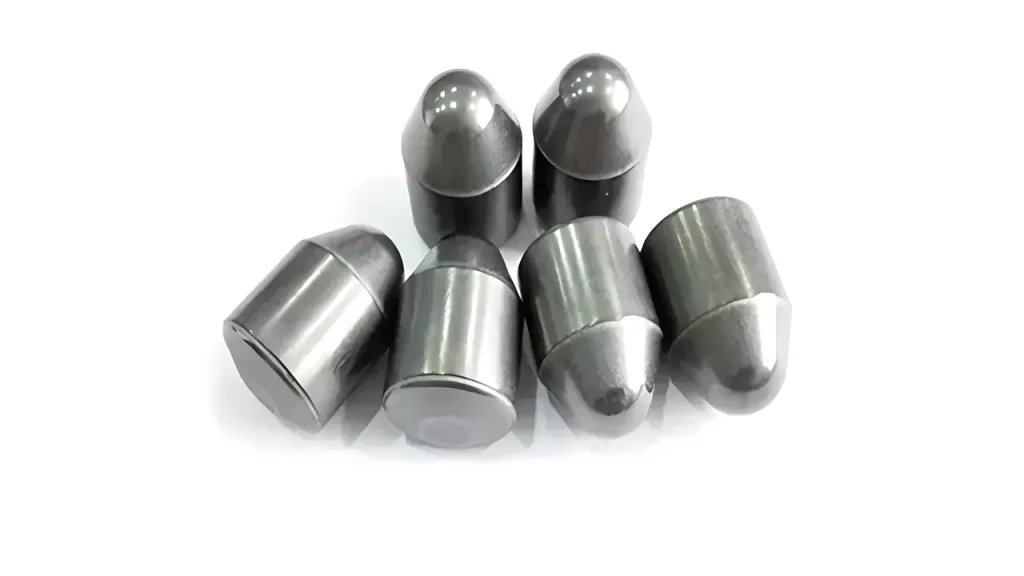
Inserting carbide buttons into drill bits offers a multitude of benefits, significantly enhancing drilling performance and cost-effectiveness. These benefits are derived primarily from the exceptional properties of tungsten carbide itself, a material renowned for its hardness and wear resistance. Key advantages include:
- Extended Tool Life: Carbide buttons drastically increase the lifespan of drill bits compared to traditional steel bits, as they resist abrasion and wear even in the most challenging rock formations. This reduces the frequency of bit replacements and associated downtime.
- Superior Penetration Rates: The extreme hardness of carbide allows for more aggressive cutting and faster penetration into hard and abrasive materials, leading to improved drilling efficiency and higher productivity.
- Enhanced Durability and Impact Resistance: Properly inserted carbide buttons can withstand significant impact forces and maintain their structural integrity, minimizing chipping and breakage during percussive drilling.
- Cost Savings: While the initial cost of carbide button bits might be higher, their extended lifespan, reduced need for replacements, and increased drilling efficiency ultimately translate into substantial long-term cost savings in labor, equipment, and project timelines.
- Versatility in Applications: Carbide button bits are highly versatile and effective across a wide range of geological conditions and drilling applications, including mining, quarrying, construction, and oil and gas exploration.
Inserting Carbide Button Uses
Carbide buttons, due to their exceptional hardness, wear resistance, and ability to withstand high temperatures and pressures, are indispensable components across numerous heavy-duty industries. Their primary function is to enhance the cutting, crushing, and abrasion resistance of tools, significantly extending their operational life and improving efficiency. These small but robust inserts are crucial where conventional steel tools would quickly fail under demanding conditions.
The versatility of inserted carbide buttons means they are employed in a wide array of applications, primarily focused on drilling, cutting, and wear protection:
- Mining and Drilling: This is arguably the largest application, where carbide buttons are integrated into various drill bits like DTH (Down-The-Hole) bits, tricone bits, and top hammer drill bits. They are essential for penetrating hard rock formations, ore, and coal in mining operations, oil and gas exploration, and geotechnical drilling.
- Construction: In the construction sector, carbide buttons are vital for tools used in breaking, cutting, and drilling through tough materials such as concrete, asphalt, and stone. They are found in road milling picks, foundation drilling tools, and tunnel boring machine (TBM) cutterheads.
- Heavy Machinery and Wear Parts: Beyond drilling, carbide buttons are used as wear-resistant components in heavy machinery. Examples include crusher tips for fragmenting stone and ore, and various parts exposed to severe abrasion, ensuring longevity and reducing maintenance in industrial equipment.
- Other Specialized Applications: Their unique properties also make them suitable for niche uses like snow removal equipment (in snow ploughs and road maintenance tools), certain woodworking tools requiring high precision and durability, and even in some metalworking cutting tools for machining alloys.
Conclusion
In summary, the choice among hot pressing, cold pressing, and brazing for inserting carbide buttons significantly impacts a button bit’s performance and longevity. Each method offers unique benefits, from enhanced bonding strength to cost-effectiveness, tailored for diverse drilling applications and rock formations.
Optimizing the insertion technique is paramount for maximizing drilling efficiency and reducing operational costs. A well-constructed button bit ensures superior penetration rates and extended tool life, directly translating to increased productivity on the job site.
For high-quality, durable carbide button bits utilizing these advanced insertion methods, consider Sinodrills. We offer a wide range of wholesale carbide button bits designed to meet the rigorous demands of modern drilling operations, ensuring you get reliable performance and exceptional value.

